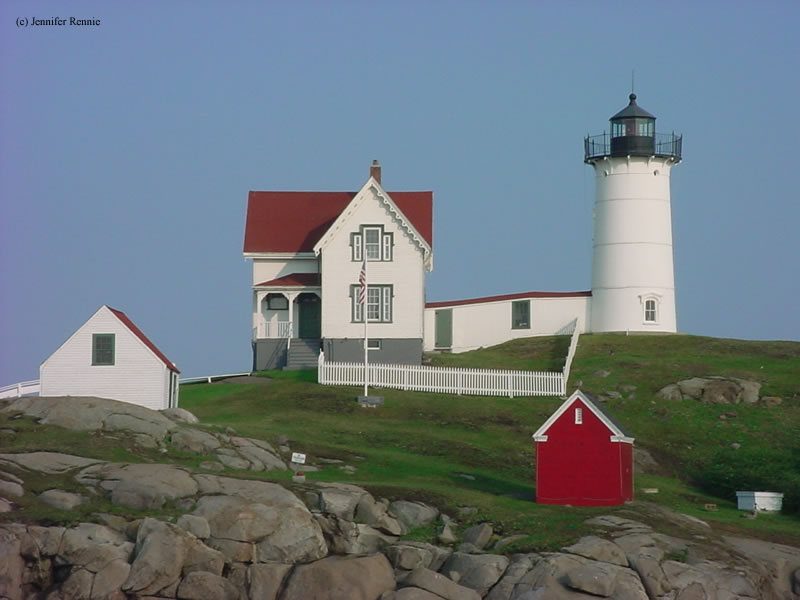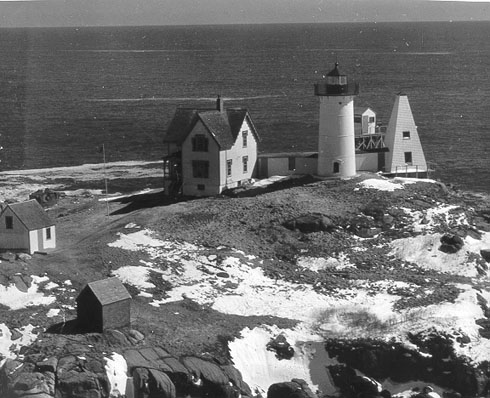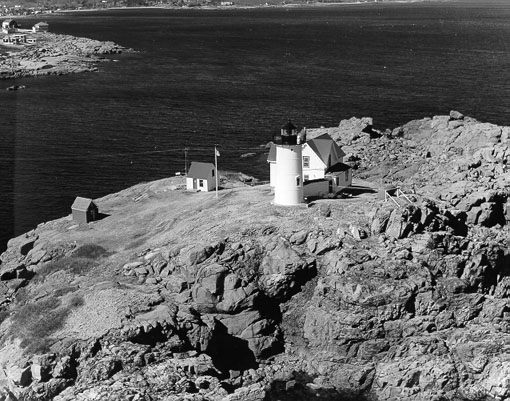Cape Neddick (Nubble) Lighthouse
York, Maine - 1879 (1874**)

History of the Cape Neddick (Nubble) Lighthouse
Posted/Updated by Bryan Penberthy on 2016-10-16.
The Cape Neddick Lighthouse, commonly called "The Nubble Light," sits on a high, rocky island known locally as the Nubble. The Nubble is roughly two-and-one-half acres in size, and is separated from the mainland by a small channel, barely 100 feet wide. In fact, during low tide, it appears more as a peninsula.
English explorer Bartholomew Gosnold led the first recorded European expedition to the New World, where he had planned to form the first English colony. Gosnold arrived in Cape Elizabeth, Maine in May of 1602, and from there, headed south.
As his group headed south, they encountered Indians in York, Maine, and dubbed the Nubble as "Savage Rock." As the expedition continued south, Golsnold was credited with naming Cape Cod and Martha's Vineyard.
Although "Savage Rock" never stuck, another English expedition, led by Captain John Smith in 1614 would explore the areas of Maine and Massachusetts. It was during this trip that the area would be called "New England." On this same trip, a member of Captain Smith's crew was credited with naming the Nubble, which at the time appeared as "Knubble" in various records.
By the 1800s, York was thriving with shipbuilding, fishing, and trade. It was in 1807 when local mariners first requested a lighthouse on the Nubble. The requests went unanswered for nearly three decades, but on March 3, 1837, Congress had appropriated $5,000 for a lighthouse.
Captain Joseph Smith of the U.S. Revenue Cutter Service had recommended against a light on the Nubble as there were already many lighthouses in the area, specifically Boon Island and Whaleback Island, both near York, Maine, and Portsmouth Harbor Light in New Hampshire.
Captain Smith instead recommended an unlighted beacon at York Ledge, about two miles offshore, and recommended a lighthouse at Stage Neck, which would guide vessels into the York River. Boston architect Alexander Parris was called upon to design the beacon for York Ledge, which was erected shortly thereafter. The lighthouse at Stage Neck was never built.
After additional shipwrecks in the vicinity, the subject of a lighthouse came up again. Congress again appropriated $5,000 in 1851, but after discussions, the project died. It would come up again in 1874, when the following entry appeared in the Annual Report of the Lighthouse Board:
Cape Neddick, (York Nubble,) coast of Maine - The erection of a lighthouse at this point for the benefit of the coasting-trade is considered of importance, and an appropriation of $15,000 is asked for that purpose.
The request was repeated again in 1875, and an act approved by Congress on July 31, 1876 appropriated the necessary funds. Due to the burgeoning tourism in the area, a hotel was planned near the proposed site of the lighthouse. Due to the planned hotel and the fact that the property was owned by multiple entities, the project stalled.
 Nubble Lighthouse with Bell Tower (Courtesy Coast Guard)
Nubble Lighthouse with Bell Tower (Courtesy Coast Guard)
By early 1879, the U.S. Government had paid $1,500 for the island and had clear title to the land. This allowed construction of the Cape Neddick Lighthouse to start. General James Chatham Duane, an engineer with the Lighthouse Board, was placed in charge of the construction.
As the lighthouse was of cast-iron, the sections were manufactured at a foundry in Portland. Once the sections were completed, they were transported to the island in April 1879 aboard the lighthouse tender Myrtle and the station was completed by that June.
When completed, a 41-foot tall cast-iron tower stood atop the island, with a keeper's dwelling 50 feet to the north. Inside the lantern was a fourth-order Fresnel lens, which displayed a fixed red light from the focal plane, 88 feet above mean high water. The light was first activated on July 1, 1879.
Before the Cape Neddick Lighthouse was placed into service, Leander White was appointed Keeper, but he was soon reassigned to the Whaleback Lighthouse. Simon Leighton was then appointed keeper, but he resigned in June 1879 due to illness. Nathaniel H. Otterson was then appointed keeper.
A boathouse and slip were built in 1888 and then extended a year later. At that time, steps were added to access the station. The boat slip was again extended in 1900.
Although the station had a fog bell with an automated striking mechanism from its start in 1879, in 1891, the striking mechanism from the Pond Island Lighthouse was rebuilt, and placed into service at the Cape Neddick Lighthouse. The following is from the Annual Report of the Lighthouse Board:
57. The Knubble, on Cape Neddick, sea-coast of Maine - The bell-frame was strengthened, and the striking machine taken from Pond Island, Me., was rebuilt and set up here. The bell was changed from an inside to an outside striker, and its characteristic was changed from one blow every thirty seconds to one blow every fifteen seconds.
With the sinking of the USS Maine in Havana Harbor in February 1898, fearing war, President McKinley asked Congress to appropriate $50 million for national defense, which was approved. Out of that pool of money, most lighthouses along the East Coast were equipped with telephones. For the Cape Neddick Lighthouse, the telephone connected the station to the village of York Beach.
With tourism rising sharply in the area, from the time the lighthouse was built, it attracted visitors. The keepers quickly capitalized on the situation as evidenced by an item that was published in the August 7, 1880 edition of the Portsmouth Journal:
"Visitors are not allowed to visit the lighthouse at York Nubble between the hours of 6 P.M. and 10 A.M.; but other times the son of the keeper will row you over and back in his boat for ten cents."
This practice continued on for many years, even as visitors were occasionally injured. In one such incident a man fell and dislocated his shoulder. In another incident, a man went to the island to hunt waterfowl, but accidentally shot himself in the leg.
In 1898, the Lighthouse Board ordered the Brackett Lewis, the keeper to no longer allow visitors to the station on Sundays. The Board was worried that it was interfering with duties. William M. Brooks took over duties in 1904, and continued the "business" of ferrying sightseers to the island. But Brooks provided an additional service by keeping a supply of fishing gear and bait on the island.
The Lighthouse Board noted that Brooks had as many as "200 to 300 people at certain times to roam about the reservation with only the keeper's wife to care for the government property." Brooks later recalled in an interview that he charged 10 cents for the round-trip ferry service to the island, and charged an additional five cents for a tour of the station, which was led by his wife. He resigned in 1912 and later operated the Bay View Hotel in York Beach.
At some point, the standard was changed and keepers were no longer allowed to charge passengers for trips to the island. In 1921, Keeper William Richardson was discharged for ferrying passengers to the station for a fee. Over the years, visitors still came to the island. Between 1930 and 1934, the guest register at the station showed totals from 722 to 1092 visitors yearly.
One of the island's most famous residents was Sambo Tonkus, commonly known as Mr. T., who was the pet cat of one of the keepers. Over the years, the cat had become so attached to the Nubble that they left him behind.
By the time Eugene Colemon arrived in 1930, Mr. T weighed in at 19 pounds, was said to have paws the size of a dog's, and was well known to the locals and tourists for his swimming and mousing abilities. After the cat cleared the island of mice, he would swim to the mainland several times a day to hunt rodents hiding among the rocks. Local newspapers, even had stories on the famous "swimming cat."
 Nubble Lighthouse without Bell Tower (Courtesy Coast Guard)
Nubble Lighthouse without Bell Tower (Courtesy Coast Guard)
Electricity made it to the island in 1938, which enhanced the candlepower of the light. Several years later, during World War II, the light was extinguished. A lookout tower was erected on the island and was staffed by the Coast Guard, which were tasked with a 24-hour lookout for German U-boats. On one occasion in 1943, a submarine was spotted, but was later sunk by a depth charge near the Boon Island Lighthouse.
Plans were made to automate the station in 1987, which greatly upset the local community. When the contractor arrived to install the automation equipment, to avoid trouble, he told the locals that had assembled onshore that he was merely going out to fix the bathroom. On the night of July 13, 1987, more than 300 people were on hand to witness the automation ceremonies.
Two years later, the Town of York was granted a 30-year lease to take over the upkeep of the Cape Neddick Lighthouse. That year, the town received a grant from the Maine Historic Preservation Commission to replace two second-story windows with a single larger window, which was similar to what had originally been installed.
The Town of York applied for ownership of the Cape Neddick Lighthouse in 1997 under the Maine Lights Program. The process was officially completed in 1998, and was managed by York's Parks and Recreation Department.
Today, the lighthouse is easily viewed from Sohier Park. The most popular event is the annual Lighting of the Nubble, a tradition started in the 1980s, when a Margaret Cummings, a volunteer donated some Christmas lights in memory of her sister.
During the event each November, the tower and other buildings are illuminated with holiday lights and accompanied by music. As the event became popular, it was later adopted to a Christmas-in-July event to allow summer visitors the experience.
There is no denying the popularity of the Cape Neddick Lighthouse. It is definitely one of the most photographed lighthouses in New England, next to the Portland Head Lighthouse. It is so popular that a photo of the Nubble Lighthouse was sent into space aboard the Voyager II, in an attempt to teach possible extraterrestrials about our planet.
Reference:
- Annual Report of the Light House Board, U.S. Lighthouse Service, Various years.
- The Lighthouses of Maine: Southern Maine and Casco Bay, Jeremy D'Entremont, 2013.
- The Lightkeepers' Menagerie: Stories of Animals at Lighthouses, Elinor De Wire, March 15, 2007.
Directions: The lighthouse sits on an island just off shore, but views from the mainland are possible. From Alt US-1 (Long Beach Ave.) in the Town of York Beach, head east on Nubble Road. Follow that to Sohier Park. From here, you can see the lighthouse out on an island just off shore. During low tide, several books report that it is possible to wade to the island. This is a violation of a York Ordinance, so please don't do it.
Access: The lighthouse is owned by the Town of York, Maine. Grounds / tower closed. But the lighthouse is easily viewed from Sohier Park.
View more Cape Neddick (Nubble) Lighthouse picturesTower Height: 41.00'
Focal Plane: 88'
Active Aid to Navigation: Yes
*Latitude: 43.16522 N
*Longitude: -70.59110 W
See this lighthouse on Google Maps.
